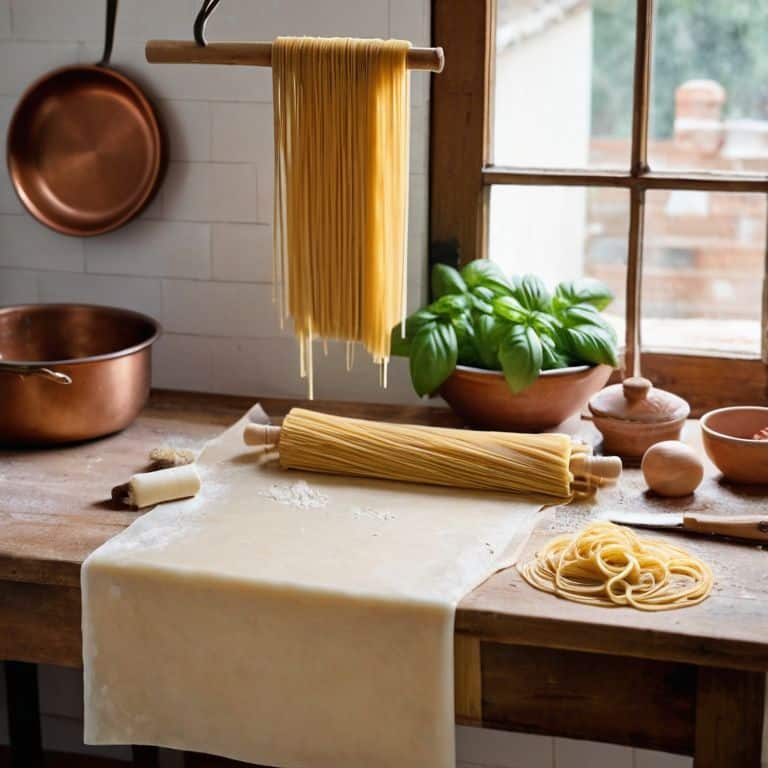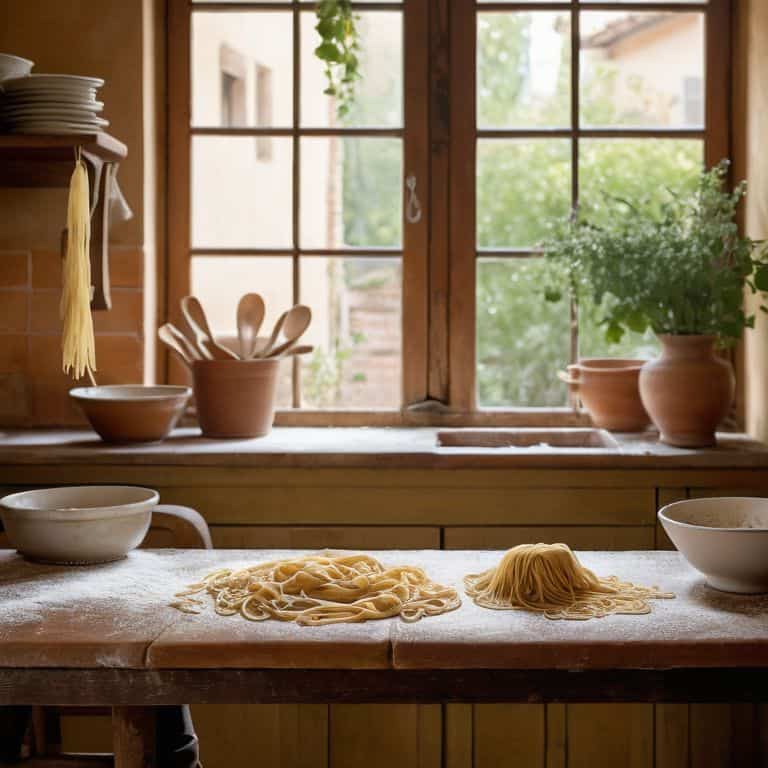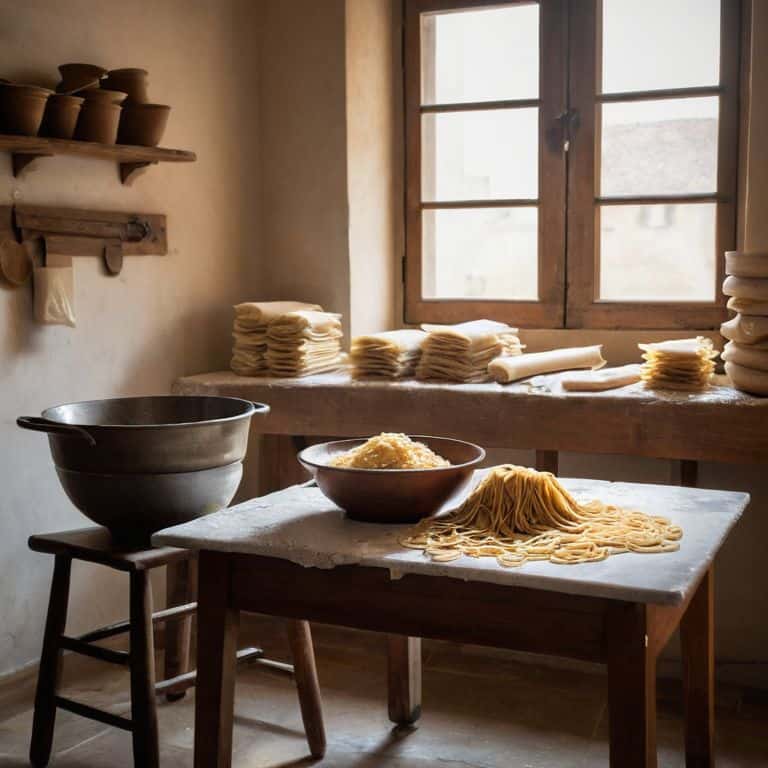I still remember the first time I made homemade pasta from scratch – it was a game-changer. But what really made the difference was using the best flour for homemade pasta. I’ve tried various types, but I swear by ’00’ flour for the fluffiest, most tender noodles. There’s something about the smell of freshly baked bread and the sound of sizzling garlic that just makes me feel like I’m in my element. When it comes to making homemade pasta, I believe that the type of flour you use can make or break the dish. That’s why I’m always on the lookout for the perfect flour that will give me that perfect texture.
In this article, I promise to share my honest, no-nonsense advice on how to choose the best flour for your homemade pasta needs. I’ll cut through the hype and give you the lowdown on what really works, based on my own experiences in the kitchen. Whether you’re a seasoned pro or a beginner, I’ll provide you with the essential tips and tricks you need to make delicious, satisfying homemade pasta that will impress your family and friends. So, let’s get started on this culinary journey together, and I’ll show you that making homemade pasta is not as intimidating as it seems. With the right flour and a little practice, you’ll be a pro in no time!
Table of Contents
Best Flour for Homemade Pasta

When it comes to making incredible homemade pasta, the type of flour you use is crucial. I’ve experimented with various italian flour types, and I can confidently say that ’00’ flour is my go-to choice. The flour protein content in ’00’ flour is just right, resulting in a pasta dough consistency that’s easy to work with and yields a tender, yet firm texture.
I’ve tried using caputo flour vs all purpose flour, and while both have their merits, I find that ’00’ flour produces a more authentic Italian pasta experience. The lower protein content in ’00’ flour helps to prevent the pasta from becoming too chewy or dense. When combined with the right techniques, such as homemade pasta drying techniques, you’ll be rewarded with a deliciously fresh and homemade pasta that’s sure to impress.
To achieve the perfect pasta, it’s essential to understand the role of flour in the dough. Flour protein content for pasta is a critical factor, as it affects the final texture and consistency of the pasta. By choosing the right flour and mastering the art of making homemade pasta, you’ll be able to create a wide range of delicious dishes that are sure to become family favorites. Whether you’re a seasoned chef or a beginner in the kitchen, using the right flour will make all the difference in the world.
Pasta Dough Consistency Secrets
To achieve the perfect pasta dough, you need to focus on pasta dough consistency, which is all about finding the right balance between dry and moist ingredients. I’ve learned that it’s all about feeling the dough as you mix it, allowing it to come together in a beautiful, pliable ball.
When you’ve reached the ideal consistency, your dough should be smooth and slightly firm to the touch, with no cracks or tears. This is where the magic happens, and gentle kneading becomes your best friend, helping to develop the gluten and create a tender, yet elastic texture that will make your homemade pasta truly unforgettable.
Uncovering Italian Flour Types
When it comes to making homemade pasta, understanding the different types of Italian flour is essential. I’ve found that using high-protein flour can make all the difference in achieving the perfect texture. Italian flour, also known as “00” flour, is a popular choice among pasta enthusiasts.
To create authentic Italian pasta, it’s crucial to choose the right flour type. I recommend exploring the various Italian flour options, such as Caputo or All-Purpose flour, to find the one that works best for you.
Making Perfect Homemade Pasta

As I dive into the world of making perfect homemade pasta, I always start with the foundation: creating a harmonious balance of ingredients. The type of flour used plays a significant role in determining the final texture and taste of the pasta. I’ve found that using high-quality Italian flour types, such as Caputo flour, yields a more delicate and tender noodle compared to all-purpose flour.
When it comes to pasta dough consistency, it’s all about finding that sweet spot where the dough is pliable but not too sticky. The flour protein content is crucial in achieving this balance, as it affects the gluten structure and ultimately the texture of the pasta. I’ve experimented with various flour substitutes, but I always come back to the traditional Italian flours for their unmatched quality and consistency.
To take my homemade pasta to the next level, I’ve also mastered the art of homemade pasta drying techniques. By gently laying out the freshly made noodles on a clean towel or pasta drying rack, I allow them to dry slowly and evenly, preventing any unwanted moisture from accumulating. This step may seem simple, but it’s essential in preserving the delicate texture and flavor of the pasta, making it truly exceptional.
Caputo vs All Purpose Flour Showdown
When it comes to making homemade pasta, the type of flour you use can make all the difference. I’ve tried various types, but my favorite flour showdown is between Caputo and all-purpose flour. Caputo flour, also known as “00” flour, is a finely milled Italian flour that produces a tender and delicate pasta.
In my experience, using high-quality ingredients like Caputo flour can elevate your homemade pasta to the next level. While all-purpose flour can still produce a delicious pasta, it often lacks the same level of texture and flavor as Caputo flour.
Drying Techniques for Freshly Made Pasta
When it comes to drying freshly made pasta, I always say that air drying is the way to go. There’s something about the gentle rustle of the pasta as it dries that just feels right. To do it, simply lay your freshly cut pasta out in a single layer on a clean towel or pasta drying rack.
For more delicate shapes, I recommend using a clean cloth to gently pat them dry before laying them out to air dry. This helps prevent any sticky spots from forming and ensures your pasta cooks evenly.
My Top 5 Secrets to Choosing the Best Flour for Homemade Pasta
- Opt for ’00’ flour for the fluffiest, most tender noodles you’ve ever tasted – trust me, it’s worth the extra cost!
- Understand the difference between Italian ’00’ flour, all-purpose flour, and bread flour to determine which one suits your pasta recipe best
- Don’t overlook the importance of protein content in your flour – it can make or break the texture of your homemade pasta
- Experiment with different flour blends, like combining ’00’ flour with semolina, to create a unique flavor and texture profile
- Remember, the best flour for homemade pasta is one that balances strength, elasticity, and extensibility – so don’t be afraid to try new types and ratios until you find your perfect match
Key Takeaways for the Perfect Homemade Pasta
Using high-quality ’00’ flour is crucial for achieving tender and fluffy homemade pasta noodles
Mastering the right pasta dough consistency, which should be smooth and pliable, is essential for successful homemade pasta
Drying freshly made pasta properly, either by air-drying or using a pasta drying rack, helps preserve its texture and prevents it from becoming sticky or mushy
The Heart of Homemade Pasta
The right flour is more than just an ingredient – it’s the foundation of a delicious homemade pasta that will leave everyone craving for more, and I truly believe that with the perfect flour, you can taste the love and care in every single bite.
Sophie Carter
Bringing it all Together: The Perfect Homemade Pasta

As we’ve explored the world of homemade pasta, it’s clear that the right flour makes all the difference. From uncovering Italian flour types to mastering pasta dough consistency secrets, and even comparing Caputo vs all-purpose flour, we’ve covered the essentials. By choosing the best flour for your needs and following a few simple tips, you can create delicious, tender noodles that will impress anyone. Whether you’re a seasoned pro or a beginner, remember that practice makes perfect, and don’t be afraid to experiment until you find your ideal recipe.
So, the next time you’re in the kitchen, don’t be intimidated by the idea of making homemade pasta from scratch. With the right flour and a little patience, you can create something truly special. As you sit down to enjoy your freshly made pasta, remember that the joy of cooking is just as important as the end result. The process of creating something with your own hands, the smell of flour and eggs in the air, and the taste of a perfectly cooked noodle – it’s all part of the experience. Happy cooking, and I hope to see you in the kitchen, surrounded by the simple pleasures of homemade pasta!
Frequently Asked Questions
What's the difference between using '00' flour and all-purpose flour for homemade pasta?
Honesty time: ’00’ flour and all-purpose flour yield different results. ’00’ flour produces a more delicate, tender pasta, while all-purpose flour gives a slightly denser, more rustic texture. I swear by ’00’ flour for its superior flavor and mouthfeel, but all-purpose can still make delicious pasta – it just depends on the vibe you’re going for!
Can I use bread flour as a substitute for '00' flour in pasta making?
Honestly, while bread flour can work in a pinch, it’s not my top choice for pasta. The higher protein content can make the dough slightly tougher, but if that’s all you have on hand, just be prepared to knead a bit longer and adjust your hydration levels.
How does the protein content in different types of flour affect the texture and consistency of homemade pasta?
The protein content in flour is a total game-changer for homemade pasta. Generally, higher protein flours like ’00’ or bread flour will give you a more tender, yet firm texture, while lower protein flours like all-purpose can result in a softer, more delicate noodle. I swear by using a high-protein flour for my signature pasta dishes!
